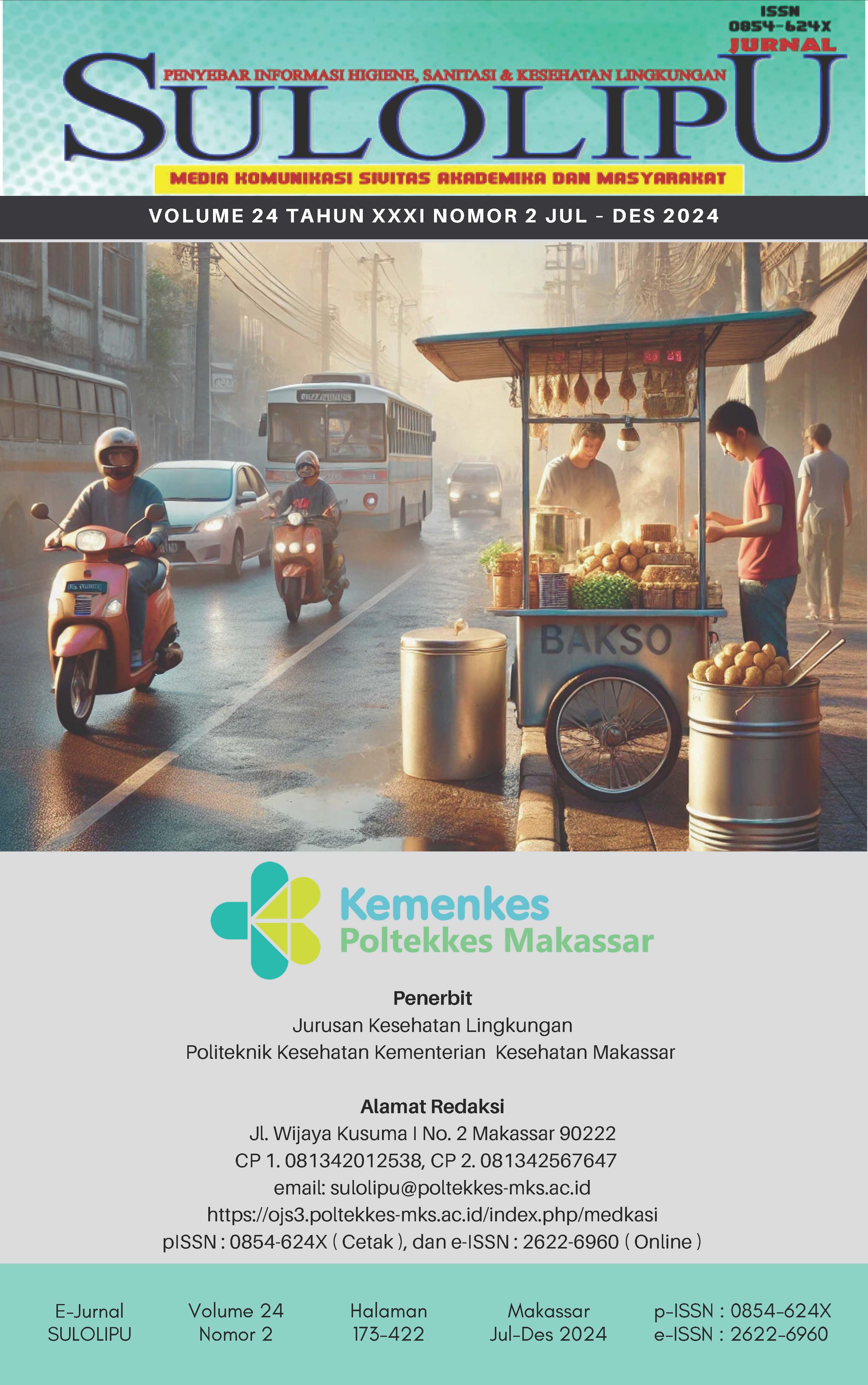Factors Affecting Non-Fulfillment of Pillar 4 and Pillar 5 in the Campalangian Health Center Working Area, Campalangian District, Polewali Mandar Regency
DOI:
https://doi.org/10.32382/sulo.v24i2.973Keywords:
STBM, Lingkungan, Sumber Daya Manusia, RegulasiAbstract
Community Led Total Sanitation or CLTS is an approach to changing hygiene and sanitation behavior through the triggering method. Sanitation is still a household problem that will have direct or indirect impacts on health and the environment in an area. This study aims to determine the factors that influence the non-fulfillment of CLTS pillar 4 and pillar 5 in the working area of the Campalagian Health Center, Kec. Campalagian, Kab. Polewali Mandar. This type of research is analytic observational with a cross sectional approach, and uses a sample of 80 households with a sampling method that uses Simple Random Sampling. For data processing using the chi-square statistical test with the help of computer software. The results showed that there was an effect of not fulfilling CLTS Pillar 4 and Pillar 5 ehich included environmental factors, human, resources, and regulations. Based on the statistical test result for environmental factors, namely pilllar 4 the result were p = 0.003, and pillar 5 was p = 0.004, while for the human resource factor, namely pillar 4 the fresult were obtained p = 0,000 and pillar 5 p = 0.004 and for regulatory factors that is on pillar 4 the value of p = 0.004 is obtained, and pillar 5 p = 0.002. This is because most people think that the facilities for garbage disposal and the management of household liquid waste are not important enough to have. The conclusion of this study is that there is an influence between environmental factors, human resources, and regulations on the non-fulfillment of CLTS pillars 4 and pillar 5. So that the community is advised to be able to implement the of CLTS Pillar 4 program such as providing waste disposal facilities and Pillar 5 such as making SPAL (canal waste water disposal) in accordance with health requirements.
Keywords : CLTS Pilar 4 dan 5; Enviroment; Resources People and Regulation
References
Azizah, N., Ardillah, Y., Sari, I. P., & Windusari,Y.(2021).Sanitasi Total Berbasis Masyarakat (STBM) diLingkungan Kumuh Kota Palembang:Studi Kualitatif. Indonesia,20(2),673.(Online.)https ://doi.org/10.14710/jkli.20.2.65-73 (Diakses pada tanggal 18 januari 2023)
Benga, D., Suhartono, S., & Wahyuningsih, N. E. (2022). Pemantauan Dan Evaluasi Pelaksanaan Program Stbm Diwilayah Kerja Puskesmas Jawakisa Kecamatan Aesesa SelatanKabupatenNagekeopropin si Nusa Tenggara Timur. Jurnal KesehatanMasyarakat(Undip),10( 2),191200(Online).https://doi.org/ 10.14710/jkm (Diakses pada tanggal 11 januari 2023)
Direktorat Jenderal Penyehatan Lingkungan, K. K. (2012). Pedoman Pelaksanaan Teknis STBM. Kesehatan, 1–72 (Online). https://www.google.com/url?sa=t& rct=j&q=&esrc=s&source=web&cd =&ved=2ahUKEwi9o_Kf_(Diakses pada tanggal 17 januari 2023)
Elamin, M. Z., Ilmi, K.(2018). Analysis of Waste Management in The Village of Disanah, District of Sreseh Sampang, Madura. Jurnal KesehatanLingkungan,10(4),368.( Online).https://doi.org/10.20473/jk l.v10i4.2018.368-375 (Diakses pada tanggal 20 april 2023)
Fahri, Sukmal. (2021). Bahan Ajar Sanitasi Total Berbasis Masyarakat. (online).https://books.google.co.id /books (diakses pada tanggal 17 Januari 2023)
Hidayat,dkk. (2017). Hubungan STBM Pilar IV dengan Kejadian Penyakit ISPA di Wilayah Kerja Puskesmas Salupangkang Kec . Topoyo KabupatenMamujuTengah.(Online ).https://www.google.com/url?sa=t &rct=j&q=&esrc=s&source=web& (Diakses pada tanggal 22 juni 2023)
Kementrian Lingkungan Hidup dan Kehutanan.(2021).Jumlahtimbula nsampahindonesia.(Online).https: //bshilhk.menklhk. (diakses pada tanggal 17 januari 2023)
Kementrian Kesehatan RI .(2020). Website Sanitasi Total Berbasis Masyarakat. Avaible at:(Online). http://stbm.kemkes.go.id/ (di akses pada tanggal 18 Januari 2023)
Monica, D. Z., Ahyanti, M., & Prianto, N. (2021). Hubungan Penerapan 5 Pilar Sanitasi Total Berbasis Masyarakat (Stbm) Dan Kejadian Diare Di Desa Taman Baru Kecamatan Penengahan Kabupaten Lampung Selatan. Ruwa Jurai: Jurnal Kesehatan Lingkungan, 14(2), (Online).https://doi.org/10.26630/rj .v14i2.2183 (Diakses tanggal 23 april 2023)
Nasution, N. (2018). Program studi ilmu kesehatan masyarakat stikes aufa royhan kota padangsidimpuan tahun 2018 (Online). https://www.google.com/url?sa=t& rct=j&q=&esrc=s&source=web (Diakses pada tanggal 13 april 2023)
Putra, D. P.,Masra,F., &Prianto, N. (2022). Penerapan Pengelolaan Sampah Dan Air Limbah Rumah Persada Kota Bandar Lampung. 16(2), (Online). https://www.google.com/ur l?sa=t&rct=j&q=&esrc=s&source= web&2Fejurnal.poltekkesPratama. (Diakses pada tanggal 18 januari 2023)
Pelaksanaan, G., Total, S., Masyarakat, B., & Mandar, K. P. (2018). 283681 Gambaran-Pelaksanaan-Sanitasi (Online).https://www.google.com/Pelaksanaan, G., Total, S., Masyarakat, B., & Mandar, K. P. (2018). 283681 Gambaran-Pelaksanaan-Sanitasi (Online).https://www.google.com/url?sa=t&rct=j&q=&e=s&source= wnal.lppmunasman.ac. (Diakses pada tanggal 12 januari 2023)
Probosari, I. (2020). Sampah Rumah Tangga Di Kelurahan Krobokan Kota.Semarang.UniversitasNegeri Semarang.(Online).https://www.go ogle.com/url?sa=t&rct=j&q=&esrc =s&source=web(Diakses tanggal 12 januari 2023)
Rohim, Miftahur. pada (2023). Panduan Pengelolaan Air Limbah Rumah Tangga.(online).https://books.goo gle.co.id/books. (Diakses pada tanggal 14 Juni 2023)
Sa’ban, L. M. A., Sadat, A., & Nazar, A. (2020). Jurnal PKM Meningkatkan Pengetahuan Masyarakat Dalam Perbaikan Sanitasi Lingkungan. Dinamisia : Jurnal Pengabdian Kepada Masyarakat, 5(1), 10–16. (Online)https://doi.org/10.31849/di namisia.v5i1.4365 (diakses pada tanggal 12 januari 2023)
Santosa, W., L., dkk.(2018). Kajian Lingkungan Hidup Strategis. (online).https://books.google.co.id/ books. (Diakses pada tanggal 14 Juni 2023)
Downloads
Published
How to Cite
Issue
Section
PDF (Bahasa Indonesia) downloaded: 345



















